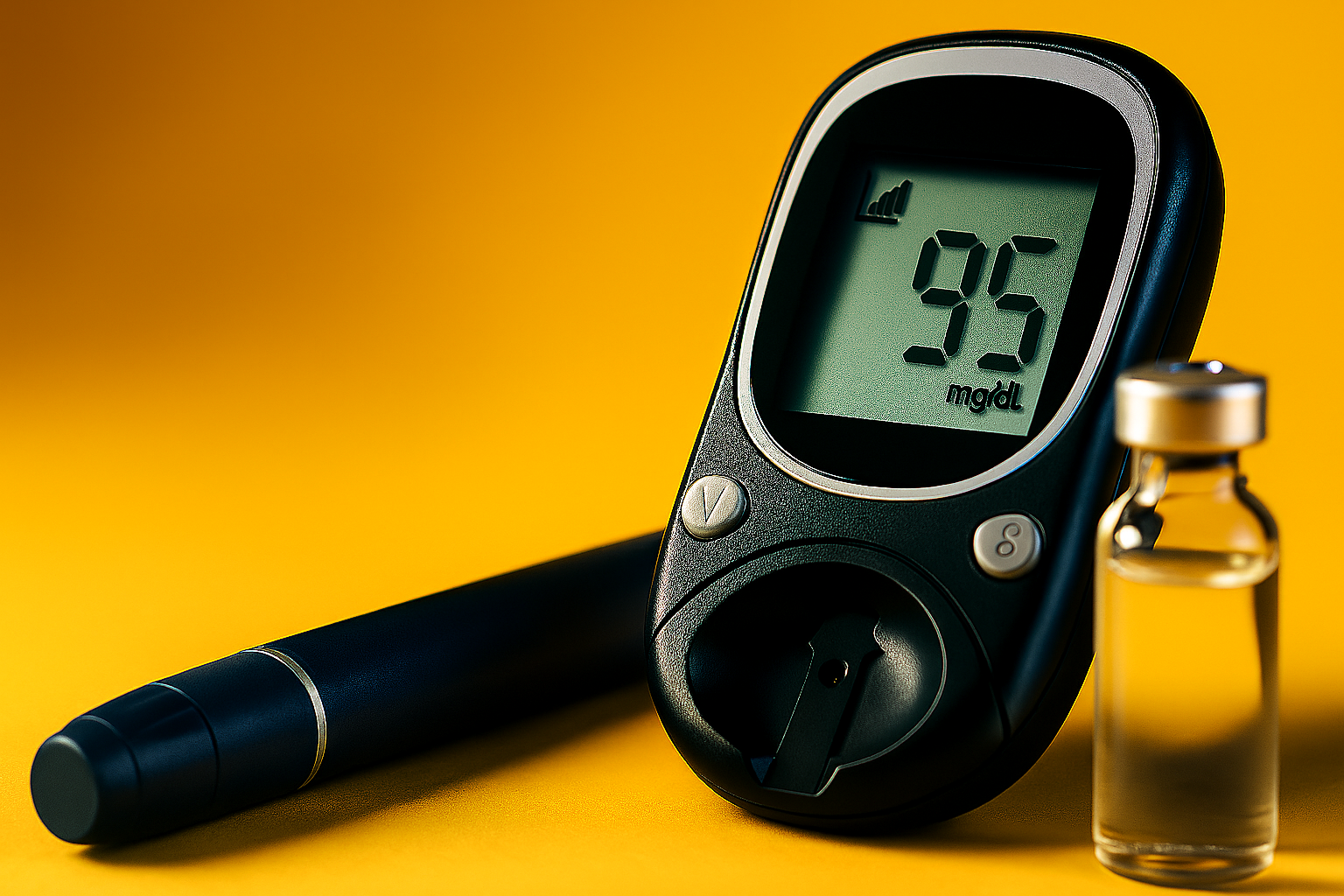Glucagon Nasal Spray Effective for Hypoglycemia Rescue
Spray device easier for untrained people to use, experts say...
- Intranasal glucagon is effective and noninferior to injectable intramuscular glucagon for the correction of insulin-induced hypoglycemia in adults with type 1 diabetes, according to a randomized, cross-over study.
- Note that hypoglycemia was induced by administering insulin in a controlled setting, but this approximates the real-world setting of severe hypoglycemia occurring due to excessive therapeutic insulin with inadequate or absent endogenous glucagon response.
- An intranasal glucagon spray was as good as injectable glucagon for treating induced hypoglycemia in patients with type 1 diabetes, according to a randomized crossover noninferiority study.
- The effect of the nasal spray lagged a few minutes behind that of injections, but it met the study's pre-defined success criteria 74 out of 75 times, compared to 75 out of 75 with injectable glucagon, reported a team of investigators led by Michael Rickels, MD, of the University of Pennsylvania in Philadelphia.
- Currently, only injectable glucagon is available for treating hypoglycemic episodes, and it comes in a powder that must be reconstituted in a diluent before injection.
- The intranasal glucagon, developed by Locemia Solutions, is in phase III clinical testing. Eli Lilly recently announced that it acquired worldwide rights to Locemia's intranasal glucagon and plans to bring it to market.
Check out an episode of the Juicebox Podcast today...
Language processing is impaired during moderate hypoglycemia
Effects of Acute Hypoglycemia on Working Memory and Language Processing...
New research sponsored by the ADA indicates that hypoglycemia causes significant deterioration in reading span and the accuracy of subject-verb agreement. Below is the research abstract from the study as well a link to the origin page. Click here to see the entire study in PDF form.
from: http://www.ncbi.nlm.nih.gov/pubmed/25758768
Effects of Acute Hypoglycemia on Working Memory and Language Processing in Adults With and Without Type 1 Diabetes.
Abstract
OBJECTIVE: To examine the effects of hypoglycemia on language processing in adults with and without type 1 diabetes.
RESEARCH DESIGN AND METHODS: Forty adults were studied (20 with type 1 diabetes and 20 healthy volunteers) using a hyperinsulinemic glucose clamp to lower blood glucose to 2.5 mmol/L (45 mg/dL) (hypoglycemia) for 60 min, or to maintain blood glucose at 4.5 mmol/L (81 mg/dL) (euglycemia), on separate occasions. Language tests were applied to assess the effects of hypoglycemia on the relationship between working memory and language (reading span), grammatical decoding (self-paced reading), and grammatical encoding (subject-verb agreement).
RESULTS: Hypoglycemia caused a significant deterioration in reading span (P < 0.001; η2 = 0.37; Cohen d = 0.65) and a fall in correct responses (P = 0.005; η2 = 0.19; Cohen d = 0.41). On the self-paced reading test, the reading time for the first sentence fragment increased during hypoglycemia (P = 0.039; η2 = 0.11; Cohen d = 0.25). For the reading of the next fragment, hypoglycemia affected the healthy volunteer group more than the adults with type 1 diabetes (P = 0.03; η2 = 0.12; Cohen d = 0.25). However, hypoglycemia did not significantly affect the number of errors in sentence comprehension or the time taken to answer questions. Hypoglycemia caused a deterioration of subject-verb agreement (correct responses: P = 0.011; η2 = 0.159; Cohen d = 0.31).
CONCLUSIONS: Hypoglycemia caused a significant deterioration in reading span and in the accuracy of subject-verb agreement, both of which are practical aspects of language involved in its everyday use. Language processing is therefore impaired during moderate hypoglycemia.
© 2015 by the American Diabetes Association. Readers may use this article as long as the work is properly cited, the use is educational and not for profit, and the work is not altered.
NEW A1c guidelines from the American Diabetes Association
The American Diabetes Association just announced their new position on A1c targets, for children under the age of 19, who live with type I diabetes. What follows are snippets from the ADA story.
The Association now recommends that children under the age of 19 diagnosed with type 1 diabetes strive to maintain an A1C level lower than 7.5 percent. Previously, target blood glucose levels – as measured by the A1C, a test that reflects average blood glucose levels over several months – could be as high as 8.5 percent for children under 6 years of age, 8.0 percent for children 6-12 years of age and 7.5 for adolescents under the Association’s guidelines. These targets were set because of concerns over complications caused by low blood glucose, or hypoglycemia.
“The evidence shows that there is a greater risk of harm from prolonged hyperglycemia that would occur if children maintained an A1C of 8.5 percent over time. This is not to say we are no longer concerned about hypoglycemia, but we now have better tools to monitor for hypoglycemia,” said Jane Chiang, MD, Senior Vice President, Medical and Community Affairs, American Diabetes Association and one of the lead authors on the Association’s Position Statement. “The 7.5 percent target is evidence-based; however, we want to emphasize that blood glucose and A1C targets must be individualized to safely achieve the best outcomes.”
I want to urge you to click over to the ADA now and find out more about the changes and the reasons behind them.
We've been aggressive with Arden's BGs for the past two years and the results have been nothing but fantastic. Arden received her latest A1c test yesterday and I'll be posting a blog tomorrow about her result and how we've been able to achieved it.
Study: Effects of Type I Diabetes on a Young Child's Brain
I'm posting chunks from a recent study that can be found on Diabetes Care (American Diabetes Association) and blurbs from a corresponding article about the study, from Reuters Health. Study text is in the left column, Reuters on the right.
I don't believe that this information should lead you to more worry (Though it likely will) but I do believe that the parents of young children, who live with type I diabetes, should be aware of the study findings. These articles are not fun to read for many reasons, but I found them to be full of the kind of information that helps me to (hopefully) avoid long-term complications for Arden.
If you are currently struggling with BGs or generally feeling down about type I - seriously - bookmark this and save it for a better day - even though you'll likely not find much of the information surprising, it is a somber reminder. My thoughts, are as always, with you and your families. - Scott
Links to the complete articles are included below, at the end of each column.
“While many children may not show overt complications from these differences in neural structure, some do have difficulties with processing speed, memory, learning, and complex cognitive functions”
Alterations in White Matter Structure in Young Children With Type 1 Diabetes
Study Objective: To investigate whether type 1 diabetes affects white matter (WM) structure in a large sample of young children.
Results: Between-group analysis showed that children with type 1 diabetes had significantly reduced axial diffusivity (AD) in widespread brain regions compared with control subjects. Within the type 1 diabetes group, earlier onset of diabetes was associated with increased radial diffusivity (RD) and longer duration was associated with reduced AD, reduced RD, and increased fractional anisotropy (FA). In addition, HbA1c values were significantly negatively associated with FA values and were positively associated with RD values in widespread brain regions. Significant associations of AD, RD, and FA were found for CGM measures of hyperglycemia and glucose variability but not for hypoglycemia. Finally, we observed a significant association between WM structure and cognitive ability in children with type 1 diabetes but not in control subjects.
Conclusions: These results suggest vulnerability of the developing brain in young children to effects of type 1 diabetes associated with chronic hyperglycemia and glucose variability.
The entire study can be found here, it includes a significant introduction, an outline of research design and methods, as well as a description of the participants, CGM use in the study, data analysis and much more.
Chronic hyperglycemia, glucose variability may affect children's brains
By Lorraine L. Janeczko
NEW YORK (Reuters Health)
"Chronic hyperglycemia and glucose variability could impact the brains of young children with type 1 diabetes, new research suggests."
"In what the authors call the largest study to date investigating white matter structure in young children with type 1 diabetes, diabetic children had widespread and significant differences in their white matter microstructure compared with nondiabetic controls."
"Compared to controls, children with type 1 diabetes had significantly reduced axial diffusivity (AD) in their frontal, temporal, parietal, and occipital lobes. Earlier diabetes onset was associated with increased radial diffusivity (RD), and longer duration was associated with reduced AD, reduced RD, and increased fractional anisotropy (FA) (all P<0.05)."
"While many children may not show overt complications from these differences in neural structure, some do have difficulties with processing speed, memory, learning, and complex cognitive functions which can be associated with poor neuronal function," she said.
"I believe that these effects could be improved with good glycemic control, although an empirical investigation would help to answer this question. It seems that in the quest to prevent hypoglycemia in children with diabetes, there has been an increase in hyperglycemia in many children. It may be the case that a balance needs to be struck between the two extremes, perhaps with better methods of glucose monitoring."
Arden Describes a Low Blood Glucose Seizure
I had the camera out for something unrelated when Arden suddenly began to talk about a seizure that she experienced over a year before this was recorded.
Arden is three and half years old in this video, it's both heartbreaking and fascinating when you realize that she has a clear recollection of much of the event. Even more interesting is how she interprets the information. Hearing Arden describe the grunting noises that she made as her "turning into a monster" is particularly chilling.
Arden was temporarily blind and unable to speak during the seizure that she is describing. We were able to stop it in a few minutes with glucose gel.
Added 2015:
That was Arden then, this is Arden now. She is healthy, active and about as far from that little girl in the video as you can imagine.
I'm revisiting this post as a part of my podcast journey to relive Arden's Day from the beginning. Remembering the way that Arden's account of a low BG seizure (I've seen two and refuse to call them 'incidents') makes me realize why it took me so long to act boldly with insulin. I'm quite certain that as I move forward with this process of reliving the blog, I'm going to find that getting a Dexcom CGM is what allowed me to bolus with certainty while striving for closer to normal blood glucose readings.
Please don't use this video as a reason to be scared or a way to convince yourself that fear is a righteous endeavor when living with type 1. Please watch young Arden and remember that while this was once our reality, it no longer is.
I desperately want your take-away to be...

























